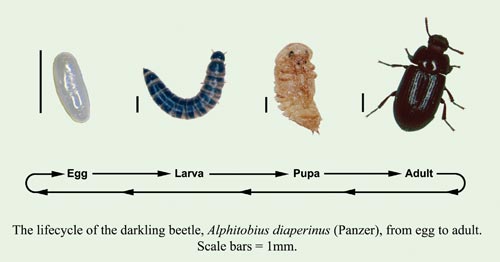Darkling Beetles
Darkling Beetles
Darkling beetles (Alphitobius diaperinus), also known as lesser mealworms, are common cosmopolitan insect pests of broiler houses where they often occur in large numbers in the bedding litter material that is used on the floors. In Australia, the floors of these houses most often consist of compacted earth and the litter bedding material is usually wood shavings. Because of the beetle’s natural association with animals, in particular birds, this tropical species is well suited to the conditions that occur in broiler houses.

Image courtesy T. Lambkin, QDPI&F
Lifecycle
Typically, darkling beetles lay eggs in the bedding litter producing larvae (lesser mealworms) that live in the litter, predominately under feed pans. These larvae then burrow into the earth floor of the broiler house to pupate, and from these pupae, the adult darkling beetle emerges. Earth floors of broiler houses are an important medium for pupation but darkling beetles still occur, albeit in smaller numbers, in broiler houses with higher density flooring materials such as concrete or bitumen.
Effects on poultry production
Despite darkling beetles occurring in most broiler houses throughout the world, the effects that these infestations have on poultry production are difficult to quantify.
In Australia, infestations contribute to:
Disease transmission
Darkling beetles are known vectors and reservoirs for a number of serious poultry disease agents (Leucosis, Marek’s disease, Infectious bursal disease, Reovirus, Enterovirus, Fowlpox and Newcastle disease) and can act as intermediate hosts for caecal nematodes, tapeworms and protozoa. In addition, they can transmit a number of foodborne pathogens such as Escherichia coli and Salmonella typhimurium and have been recently implicated in the transmission of Campylobacter. Thus, the large populations of the pest that are prevalent in most broiler houses are a bio-security threat to the welfare of the flock and the production of safe food.
Structural damage to broiler houses
In Australia, lesser mealworms tunnel readily into compacted earth floors of broiler houses, and into broiler house insulation, thereby markedly reducing its insulating value. In warmer climates, predominately in broiler houses without insulation, larvae almost exclusively tunnel into compacted earth floors resulting in the surface of the floor becoming perforated and hollowed, particularly under feed pans. These hollows retain bedding litter at litter clean out time thus reducing the effectiveness of cleanouts.
Other effects
The loss of chicken feed in broiler houses by the pest readily consuming spilt feed increases production costs, while feeding on lesser mealworms in preference to feed lowers bird nutrition. In addition, feeding on beetle larvae directly increases the likelihood of ingesting disease organisms or parasites.
Control
No acceptable field control strategies have been developed for darkling beetle control and therefore there has been little long term success in controlling the pest. Research in Australia has shown that the current standard industry insecticide is not effective when applied to broiler house floors, and this situation is exacerbated by strong and widespread insecticide resistance that occurs in broiler house beetle populations. More research is underway to develop an effective method to control darkling beetle in poultry houses.
Further Information
For more information, refer to the reading list below.
- Trevor Lambkin (2006). Poultry CRC Fact Sheet: Darkling Beetles.
- Axtell, R. C. (1985). Arthropods pests of poultry. In: Livestock Entomology, Editors: RE Williams, RD Hall, AB Bruce & PJ Scholl. Chapter 16, 269-295.
- Axtell, R. C. & Arends, J. J. (1990). Ecology and management of arthropod pests of poultry. Annual review of Entomology 35, 101-126.
- Buck, F. D. 1956. Tenebrionid coleoptera from birds’ nests in Southern Sudan. Entomologist’s Monthly Magazine 92, 13.
- Despins, J. L. & Axtell, R. C. (1995). Feeding behaviour and growth of broiler chicks fed larvae of the darkling beetle, Alphitobius diaperinus. Poultry Science 74, 331-336.
- Elowni, E. E. & Elbihari, S. (1979). Natural and experimental infection of the beetle, Alphitobius diaperinus (Coleoptera: Tenebrionidae) with Choanotaenia infundibulum and other chicken tapeworms. Veterinary Science Communications 3, 171-173.
- Goodwin, M. A. & Waltman, W. D. (1996). Transmission of Eimeria, viruses, and bacteria to chicks: darkling beetles (Alphitobius diaperinus) as vectors of pathogens. Journal of Applied Poultry Research 5(1), 51-55.
- Lambkin, T. A. (2001). Investigations into the management of the darkling beetle. A report for the Rural Industries Research and Development Corporation. RIRDC, publication number 01/151 online. November 2001.
- Lambkin, T. A. & Rice, S. (2006). Baseline responses of Alphitobius diaperinus (Coleoptera: Tenebrionidae) to cyfluthrin and detection of strong resistance in field populations in eastern Australia. Journal of Economic Entomology 99, 908-913.
- McGoldrick, S. (2004). Litter beetles – What is the economic impact, pp. 179-187. In Proceedings, Poultry Information Exchange, 18-21 April 2004, Surfers Paradise, Australia. PIX Association Inc, Caboolture, Queensland, Australia.
- Skewes, P. A. & Munroe, J. L. (1991). Research note: The effects of darkling beetles on broiler performance. Poultry Science 70, 1034-1036.
- Strother, K. O., Steelman, C. D. & Gbur, E. E. (2005). Reservoir competence of lesser mealworm (Coleoptera: Tenebrionidae) for Campylobacter jejuni (Campylobacterales: Campylobacteraceae). Journal of Medical Entomology 42, 42-47.
External links
- CSIRO Entomology: Alphitobius diaperinus (Panzer) provides information and data on Alphitobius diaperinusalso known as the ‘lesser mealworm’.
- University of Florida, Featured Creatures: lesser mealworm, Alphitobius diaperinus (Panzer) provides an introduction – synonymy – distribution – description – life cycle and biology – damage – medical importance – management and Selected References to the lesser mealworm.

